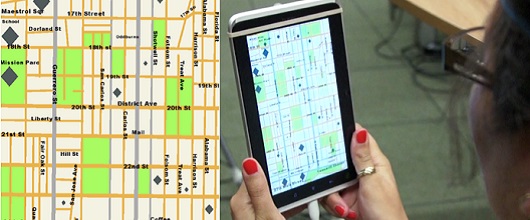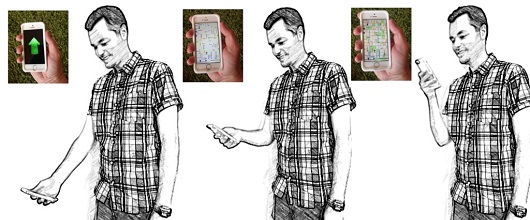Change blindness: mobile phone users miss vital information

Do you ever find it difficult to read what is on your phone? Do you bring the phone closer or move it away from face to help? New research by computer scientists at the University of St Andrews finds how mobile phone users interact with their devices could result in a phenomena known as ‘change blindness’.
The new research, led by scientists from the School of Computer Science at St Andrews, also shows that mobile proximity aware interfaces exhibit more change blindness than static displays.
Change blindness occurs when users fail to notice a single change within their field of view. The study, published by the Association for Computing Machinery (ACM) and presented at the Conference on Human Factors in Computing Systems today (25 April), shows for the first time that change blindness can affect mobile device users as they move their devices. The impact of change blindness in mobile device users could result in users missing important updates as they move their device. Mobile phone users may not notice the subtle changes in the blink of an eye or the movement of device but these can nonetheless be important.
Today, mobile phones are equipped with front facing cameras or sensors which can map a user’s face to detect its distance from the screen and when this changes. As a result, developers can create interfaces which adapt as users change their distance to the display, for example, fonts can change or their size can get bigger when further from a user’s face or more details can appear on a map when they look closer. In order to accommodate such changes fewer updates may be shown on a device from applications, such as social media updates and messages, which can be obscured as display content changes.

Proximity aware interfaces in mobile devices can allow the use of a map to navigate a city, where a user can hold the device at arm’s length and the interface would show an arrow and expected time of arrival at a destination. When users move the screen closer they would start to see some of the large roads and streets along the route but it’s only when users bring the device very close they see the street names.
A proximity aware mobile interface which exploits change blindness would aid users in trying to complete their primary task but also allow users to focus on the right level of detail, at the right moment, adding and removing visual scaffolding needed for a task.
Lead author, Professor Aaron Quigley, from the School of Computer Sciences at the University of St Andrews, said: “This research highlights the dangers this presents with important updates you might miss but also new opportunities to adapt interfaces in discreet ways which might make them easier to use, games easier or harder to play, allow for entirely new types of maps, new ways to view your messages or social media.
“Application developers need to be aware of change blindness when creating mobile interfaces to ensure important updates are not missed. These can be surprisingly large changes which many would think they won’t miss but evidence shows they do. Secondly, it will allow designers to develop new types of interfaces such as a proximity aware mobile map.”
Today we can touch and speak to our phones, but now research shows how the distance to a user’s face can be a new input. This just in time interface adaptation or awareness might mean the screen of the future using knowledge of where a user’s face is and orientation in relation to phones as a new input.
Notes to news editors/interview requests
Professor Aaron Quigley is available for interview via the Communications Office – contacts below.
A full copy of the paper ‘Change blindness in proximity-aware mobile interfaces’ is published by the Association for Computing Machinery (ACM) and can be found here.
Please ensure that the paper’s DOI (10.1145/3173574.3173617) is included in all online stories and social media posts, and that the Association for Computing Machinery (ACM) is credited as the source.
Professor Quigley’s conference presentation with images be viewed here.
Professor Quigley is currently attending the CHI conference in Montreal to present this work and in his role as the ACM SIGCHI Vice President for Conferences. Montreal is 5 hours behind BST.
To arrange an interview please contact the Communications Office in the first instance.
Issued by the University of St Andrews Communications Office. Contact Christine Tudhope on 01334 467 320/ 07526 624 243 or [email protected].
Category Research